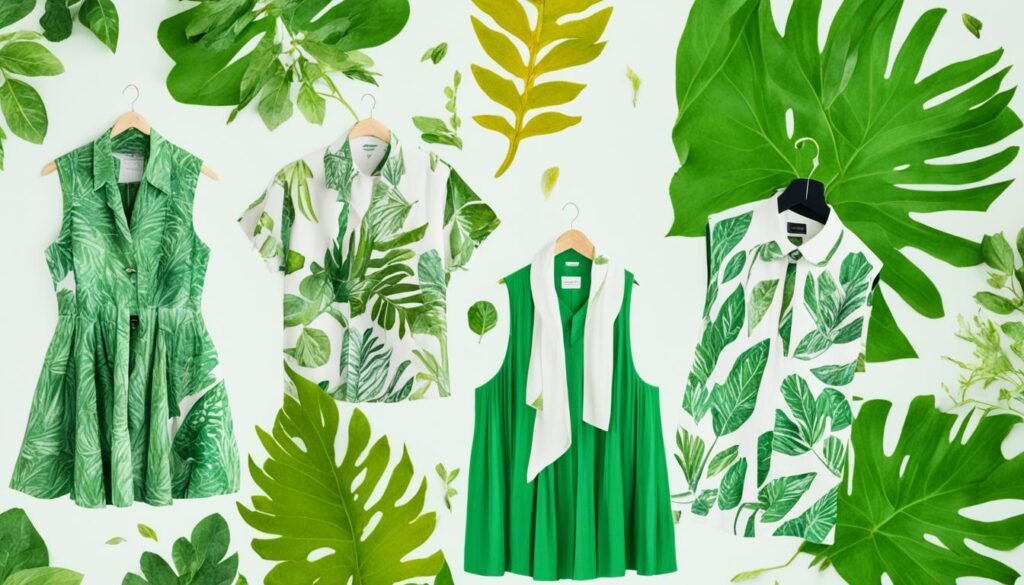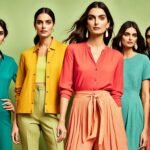Samsung Galaxy M15 5G Prime Edition (Celestial Blue,4GB RAM,128GB Storage)| Super AMOLED Display| 50MP Triple Cam| 6000mAh Battery| MediaTek Dimensity 6100+| 4 Gen. OS Upgrade & 5 Year Security Update
₹10,999.00 (as of December 21, 2024 20:33 GMT +05:30 - More infoProduct prices and availability are accurate as of the date/time indicated and are subject to change. Any price and availability information displayed on [relevant Amazon Site(s), as applicable] at the time of purchase will apply to the purchase of this product.)Finding eco-friendly apparel brands is more than just about clothes. It’s about making a difference with ethical manufacturing, organic fabrics, and fair trade practices. The fashion industry changes fast with new trends. Yet, the trend for sustainability is forever.1Consumers care more about how their purchases affect the planet. That’s why sustainable fashion brands are becoming so popular. These brands focus on doing things right. This means fair wages, good working conditions, and using materials that are kind to the earth.2By choosing these brands, consumers can be part of a movement for positive change in the fashion world.
Key Takeaways
- Sustainable fashion brands prioritize ethical labor practices, environmental responsibility, and supply chain transparency.
- The fashion industry is a major contributor to global greenhouse gas emissions and waste, making sustainable alternatives crucial.
- Sustainable fashion utilizes eco-friendly materials like organic cotton, linen, and recycled resources.
- Sustainable practices aim to minimize waste through upcycling, recycling, and promoting a circular economy model.
- Consumers can support sustainable fashion by investing in high-quality, long-lasting pieces and adopting a more mindful approach to consumption.
Why Choose Sustainable Fashion Brands?
Today, the fashion industry faces big hurdles, like lots of waste and unfair work conditions. Choosing sustainable fashion brands is key3. These brands use ethical manufacturing and organic materials. They follow fair trade too. This lets shoppers make good impacts with their buys4.
Ethical Labor Practices
Sustainable brands care for their workers. They give fair pay and safe workplaces. They make sure their workers are treated ethically all down the line.4 Buying from these brands means you’re not supporting bad labor practices.
This helps prevent human rights abuses4.
Environmental Impact
Fashion brings a lot of harm to the planet. It uses too much water, pollutes the air, and makes lots of trash. Yet, sustainable brands are working to lessen their harm. They use eco-friendly methods like natural dyes and renewable energy4. Backing these brands can reduce the fashion world’s big environmental effects4.
Transparency
These brands show a lot about how they’re made and their goals. They tell you about their supply chain and efforts to be green. This lets shoppers pick with good info4. Knowing more helps build trust. It means you can find brands that share your values4.
Choosing sustainable brands helps make fashion more ethical and green. Plus, you get to wear awesome, quality clothes that speak to your values34.
Top Sustainable Fashion Brands

In sustainable fashion, leading brands are changing the game. They set the bar high for how fashion should be made. These brands combine high-quality style with caring for the planet and the people behind the products. Let’s highlight some top brands making a real difference:
Patagonia
Patagonia stands out in the outdoor wear world for its strong stance on being green. This brand is all about using eco-friendly materials and supporting fair trade. Plus, they fight for our environment by working with green groups and pushing for better eco policies.
Everlane
Everlane shines by being super open about where and how it makes its clothes. They go for eco-rich fabrics and work closely with makers to make sure everyone is treated fairly. Their sleek, top-quality styles and small-batch releases fit perfectly with the slow fashion movement’s aims.
Reformation
In sunny LA, Reformation crafts chic, sustainable threads. They pick recycled and natural materials, like beautiful linen and leftover fabrics. Reformation works hard to cut down on waste and keep their air clean, showing the fashion world that looking great doesn’t have to cost the earth… literally.
Veja
Veja, a sneaker brand from France, gets thumbs up for its eco-friendly and fair practices. They use green, locally sourced materials, including organic cotton and rubber from the Amazon. By leading with a strong ethical stand, Veja has set a golden standard in sustainable sneakers.
Stella McCartney
Stella McCartney brings sustainability to luxury fashion with a no-leather, no-fur rule. Protecting forests is key for them, achieved in how they source their materials. They also love recycled stuff and open up about who they work with, proving you can look glamorous while being good to the planet.
A Complete Guide to Sustainable Fashion Brands and Practices
This article is a full guide to [a complete guide to sustainable fashion brands and practices]. It shows why we should choose sustainable fashion. It lists the top sustainable brands and talks about critical issues in the fashion world. These are tackled by going sustainable. This way, shoppers can help create a fashion industry that’s both ethical and green.3
It gives 10 tips for being a sustainable shopper. It mentions the 30 Wears Challenge, which started in 2015. This challenge asks you to think before you buy. It also points out the problem of too much textile waste. Every year, tons of clothes are thrown out. Instead of tossing them, giving away clothes can let others use them. It’s a key part of keeping the fashion system from making too much waste.3
The article says it’s better to buy well-made clothes that last long even though they cost more at first. Fixing clothes you already own can also make them last longer. It mentions renting clothes as another great idea. Sites like Vestiaire Collective and The RealReal have lots of green fashion options. As more people choose [a complete guide to sustainable fashion brands and practices], the more these eco-friendly brands will grow. They’ll offer even more green choices.3
This guide also points out the importance of how clothes are made. Brands that care about the people who make their clothes are crucial. They pay fair wages and ensure safe working conditions. These ethical brands use materials that are good for the planet. Some examples include Tencel, recycled polyester, organic cotton, and wild rubber. They’re open about where they get their materials and how they make their clothes.7
Brands like Patagonia have been leaders in green fashion since 1991. They give money to help the environment from their profits. This adds to their efforts for social and green fashion.7
Designers like Mara Hoffman, Everlane, and Stella McCartney make eco-friendly clothes look great. They show that the sustainable fashion market is full of cool, quality items. By picking these brands and eco-minded shopping habits, people can really change the fashion scene. They can help it be a more ethical and earth-friendly place.7
Issues in the Fashion Industry

The fashion industry is a key part of the world economy. Yet, it struggles with serious problems. These challenges include not treating workers fairly and harming the environment. The impact of the industry goes beyond just the clothes on our backs.8
Human Rights Violations
Over 300 million people work in fashion globally. Sadly, many of these workers earn very little, are children, or face slavery. There are also issues of exploitation, especially among migrants, and gender discrimination.8 People working to fix these problems in fashion want to make labor and supply chains more open and fair.
Complex Supply Chains & Lack of Transparency
Fashion supply chains are often hard to follow, with steps all over the world. This makes it tough to stop wrongdoings and harm. The ‘hidden’ side of how our clothes are made leads to a bad reputation for the industry.
The Rate of Fashion Consumption
The fashion world moves fast, which causes lots of overbuying and waste. Every year, about 300,000 tonnes of clothes are thrown out and not reused.3 This harms our planet. Sustainable fashion wants to change this ‘use and toss’ culture.
Chemical Use in Fashion Production
Fashion uses a lot of water, about 6–9 trillion liters a year.8 Half the fabrics come from cotton that needs lots of insecticides. The chemicals used can hurt both nature and the people working with them.
Water Waste & Water Pollution
Fashion is the world’s second-biggest water user. It uses as much as 9 trillion liters a year. This, along with pollution from production, greatly harms the environment.8 Sustainable fashion is fighting to lessen these impacts.
Sustainable Practices to Adopt
Both consumers and brands play a key role in tackling fashion’s challenges. They can achieve this by embracing more sustainable methods. This involves adopting a slow fashion mentality, choosing organic and sustainable materials, and using circular economy models. These models help cut down on waste and encourage the reuse of products.4
Slow Fashion Mentality
The fashion world often moves too fast. This leads many to treat clothes as disposable items. A slow fashion approach changes this by urging consumers to buy fewer, better-quality items. These are designed to last, promoting a more thoughtful buying culture.4
Prioritize Organic and Sustainable Materials
Fashion’s impact on the environment is significant. It leads to a big share of the world’s wastewater and carbon emissions. Using organic and sustainable materials like organic cotton and recycled fabrics helps lower this impact.4
Brands moving towards such materials are also seeing their sales grow by 20% yearly.4 Shoppers show more interest in goods that are made ethically and are eco-friendly.4
Embrace Circular Economy Models
The “take, make, waste” way of the past needs to change. Circular economy models focus on reusing and recycling, cutting down waste. This approach helps fashion become more sustainable.4 Biodegradable material use has particularly reduced waste by 30% in fashion.4 Furthermore, energy-efficient practices in fashion businesses lead to a 25% drop in energy use.4
By following these steps, fashion companies can lower their environmental impact. They also attract more loyal customers. Brands that talk about their sustainability efforts have seen a 15% boost in customer loyalty.4 Working with sustainable groups has also been linked to a 25% improvement in a brand’s image.4
Becoming a Conscious Fashion Consumer
More and more people are realizing they can change the fashion world by making smart choices. This includes picking brands that care about the planet. A good first step is learning about sustainable fashion. For example, the “30 Wears Challenge” asks you to wear something at least 30 times before getting something new.
It’s key to think carefully about what clothes we buy. Why? Because throwing away old clothes is a big issue. We should share or pass on clothes to help the planet. Plus, buying items that last a long time really matters. It means we don’t need to buy new ones so often.
Choosing quality over quantity helps the environment. This idea goes against always needing the latest fashion. It’s about making and using stuff in a way that leaves little waste. This way, we can keep the Earth healthy.
Trying new ideas like renting clothes can cut down on how much we buy. And it’s good for the Earth. There are also more and more brands making clothes responsibly. This gives us greener options to shop from.
| Sustainable Fashion Insights | Data |
|---|---|
| Sustainable fashion market share | 9Sustainable fashion makes up about 10% of all fashion today, and its popularity is growing. |
| Surge in sustainable accessories | 9Cork bags’ sales have gone up 20%, showing more people want eco-friendly accessories. |
| Consumer willingness to pay more for sustainable brands | 9Almost 70% of people are happy to spend more on products from eco-friendly brands. This shows a strong desire for green fashion choices. |
| Growth in vegan fashion | 9Vegan fashion is growing by 15% each year. This means more and more people are choosing animal-friendly options. |
| Impact of capsule wardrobes | 9Capsule wardrobes are leading to a 25% drop in personal clothing purchases. It’s a step towards a more eco-savvy way to shop. |
| Decrease in textile waste generation | 9Being mindful when shopping has cut down textile waste at home by 30%. It shows that our choices really do matter. |
| Increased customer loyalty for eco-friendly brands | 9Brands using eco-friendly materials are keeping 40% more customers. This proves people feel connected to environmental efforts. |
| Projected growth of sustainable fashion market | 9The eco-fashion market will grow by 20% yearly for five years. It’s a sign that green fashion is the future. |
Your fashion choices matter a lot. By picking eco-conscious options, we help ensure a better future for fashion. This means supporting brands that make clothes the right way. Let’s all work towards a fashion industry that’s fair and kind to our planet.
Conclusion
We’ve covered a lot about sustainable fashion in this guide. It’s promising to see how conclusion on sustainable fashion is changing for the better. When we choose brands that care about fair labor, the environment, and transparency, we help make the fashion world better.10
The fashion industry is facing big challenges like fast fashion’s major role in pollution and water waste. We need to focus on these problems now. But, with the sustainable fashion movement growing, there’s hope for a better, greener future.10
Companies such as Patagonia, Everlane, and Pact are at the forefront of this change. They use eco-friendly materials and support fair jobs. These leaders are making their fashion earth-friendly. They also support good causes and use sustainable packaging.10 By choosing to support conclusion on sustainable fashion, we can help create a better fashion world and environment. Let’s all join in for a brighter tomorrow.11
Source Links
- https://www.vogue.in/fashion/content/vogues-ultimate-guide-to-sustainable-fashion
- https://www.cotstyle.com/blogs/cotstyle-fashion/sustainable-clothing
- https://www.harpersbazaar.com/uk/fashion/what-to-wear/a41158/how-to-be-sustainable-fashion/
- https://www.apparelentrepreneurship.com/20-tips-for-building-a-sustainable-fashion-brand/
- https://www.marieclaire.com/fashion/sustainable-fashion-brands/
- https://www.harpersbazaar.com/fashion/trends/g60568039/best-sustainable-brands-to-shop/
- https://medium.com/@spencer.william/the-ultimate-guide-to-sustainable-fashion-brands-1189b5dc21d5
- https://www.sustainablejungle.com/sustainable-living/ethical-sustainable-fashion
- https://www.evecork.com/blogs/eve-community/becoming-a-conscious-consumer-a-guide-to-sustainable-fashion-choices
- https://greenproductguru.com/a-comprehensive-guide-to-sustainable-fashion-brands/
- https://cybilcameron.com/sustainability/the-ultimate-guide-to-sustainable-fashion/







0 Comments